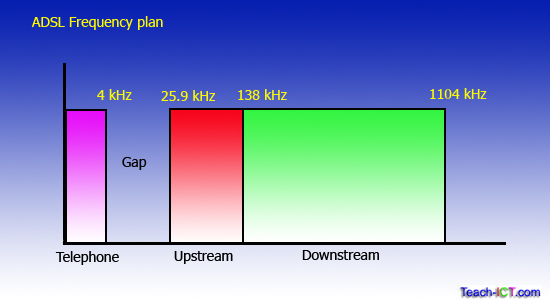2. ASDL subscriber line
Most connected homes now have an ordinary telephone line wired between the residence and the nearest telephone exchange or nearest street telephone cabinet (fibre from cabinet to the exchange)
The wires are copper and were originally designed to carry voice traffic. Voice requires only a small amount of bandwidth ( about 3.4 kHz). But luckily copper wire can handle a much larger bandwidth than this. And this is why broadband is possible over a normal telephone line.
ADSL stands for 'Asymmetric Digital Subscriber Line". Let's break down this statement to make sense of what is means
- "Subscriber Line" this is what telephone companies call the copper wire than links your home to the exchange.
- "Digital" . Normal telephone voice traffic is analogue. But alongside this, it is possible to send digital signals as well, by using the higher frequency bands that copper wire can handle.
- "Asymmetric". Means something that is uneven or not symmetric. In this case it means that the download speed is different to the upload speed. It was quickly realised that the vast majority of the time, people at home download content far more than they upload. So ADSL shares out the bandwidth available by allocating more bandwidth to downloading than uploading as shown below.

By very clever and careful digital coding within the modem, it is possible to squeeze up to 24 Mbps of digital data inside the downstream band. However, this is under almost ideal conditions! where your home is virtually next door to the exchange and no one else is also using the line. In most circumstances you get much lower download speed than this.
To overcome this fibre-to-the-cabinet is rapidly becoming the norm - so there is a fast link from the cabinet to the exchange and a normal copper wire from the home to the cabinet. This shorter length allows for faster speeds -a good fibre-to-the-cabinet offers 20 to 80 Mbps.
Some factors limiting bandwidth
- Contention ratio. This is the number of people who are using the exchange line at the same time. This is often why the internet seems slower in the evenings - there are more people sharing your line at that time of day.
- Length of wire between your home and the exchange. ADSL is only practical if you are within about three miles of the exchange. The signal simply gets weaker the longer it has to travel. Another factor often overlooked is the wiring inside your own house, your connection may be slower if your router is not connected directly to the master socket.
- Interference. Anything that causes electrical noise within the ADSL frequency band can cause it to slow down. For instance a strong AM radio transmitter nearby, or a poorly filtered telephone you have also connected to the line.
If you are curious to find out your broadband speed at home, use a search engine with the term
'uk broadband speed test'
and you will find a list of free web sites that can measure it for you in a few seconds.
challenge see if you can find out one extra fact on this topic that we haven't already told you
Click on this link: Best Broadband ISP
